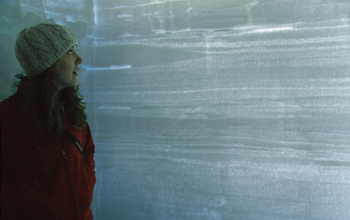![]()
Press Release 14-069
2012 Surface Melt of Greenland Ice Sheet Driven by Combined Effects of Rising Temperatures and Ash from Forest Fires![]()
Dartmouth, Desert Research Institute researchers suggest nearly annual surface melting expected by century’s end
|
Kaitlin Keegan in a snow pit on the Greenland ice sheet. The pit shows layers of accumulation. |
May 19, 2014
NSF-funded researchers at Dartmouth College and the Desert Research Institute have found that a combination of rising temperatures and ash from Northern Hemisphere forest fires caused the large-scale surface melting of the Greenland ice sheet in 1889 and 2012.
The findings also suggest that continued climate warming will result in nearly annual melting of the ice sheet’s surface by the year 2100. Melting in the dry snow region does not contribute to sea level rise; instead, the meltwater percolates into the snowpack and refreezes, causing less sunlight to be reflected–which scientists refer to as lower albedo–and leaving the ice-sheet surface even more susceptible to future melting.
“Forest fires burning far from Greenland provided the ash that, along with the warm temperatures, caused widespread melting of the Greenland Ice Sheet,” said Kaitlin Keegan, the lead author of the paper, which appears today in the Proceedings of the National Academy of Sciences.
“It required the combination of both of these effects–lowered snow albedo from ash and unusually warm temperatures–to push the ice sheet over the threshold,” said Keegan. “With both the frequency of forest fires and warmer temperatures predicted to increase with climate change, widespread melt events are likely to happen much more frequently in the future.”
The study did not focus explicitly on analyzing the ash to determine the source of the fires, but the presence of a high concentration of ammonium concurrent with the black carbon indicates the ash’s source was large boreal forest fires in Siberia and North America in June and July 2012. Air masses from these two areas arrived at the Greenland ice sheet’s summit just before the widespread melt event.
As for 1889, there are historical records of testimony to Congress of large-scale forest fires in the Pacific Northwest of the United States that summer, but it would be difficult to pinpoint which forest fires deposited ash onto the ice sheet that summer.
The research was supported by portions of several NSF awards and by NASA grant NAG04GI66G.
The massive Greenland ice sheet experiences annual melting at low elevations near the coastline, but melting at the surface is rare in the dry snow region at higher elevations in its center. In mid-July 2012, however, more than 97 percent of the ice sheet experienced surface melt, the first widespread melt during the era of satellite observation.
The Dartmouth-led team’s analysis of six Greenland shallow ice cores from the dry snow region confirmed that the most recent prior widespread melt occurred in 1889. An ice core, a cylinder of ice, from the center of the ice sheet demonstrated that exceptionally warm temperatures combined with black-carbon sediments from Northern Hemisphere forest fires reduced albedo below a critical threshold in the dry snow region and caused the large-scale melting events in both 1889 and 2012.
The researchers also used Intergovernmental Panel on Climate Change data to project the frequency of widespread surface melting into the year 2100.
If, as expected, Arctic temperatures and the frequency of forest fires increase with climate change, the researchers’ results suggest that large-scale melt events on the Greenland ice sheet may begin to occur almost annually by the end of century. These events are likely to alter the surface mass-balance of the ice sheet, leaving the surface susceptible to further melting. The Greenland ice sheet is the second largest ice body in the world after the Antarctic ice sheet.
“Our Earth is a system of systems; improved understanding of the complexity of the linkages and feedbacks, as in this paper, is one challenge facing the next generation of engineers and scientists–people like Kaitlin,” said Mary Albert, director of the NSF-supported Ice Drilling Program Office at the Thayer School of Engineering and Keegan’s doctoral adviser.
-NSF-
![]()
Media Contacts
Peter West, NSF, (703) 292-7530, pwest@nsf.gov
Principal Investigators
Kaitlin Keegan, Thayer School of Engineering, Dartmouth College, (440) 864-7796, Kaitlin.M.Keegan.TH@dartmouth.edu
Co-Investigators
Mary Albert, U.S. Ice Drilling Program Office, (603) 646-0277, Mary.R.Albert@dartmouth.edu
![]()
The National Science Foundation (NSF) is an independent federal agency that supports fundamental research and education across all fields of science and engineering. In fiscal year (FY) 2014, its budget is $7.2 billion. NSF funds reach all 50 states through grants to nearly 2,000 colleges, universities and other institutions. Each year, NSF receives about 50,000 competitive requests for funding, and makes about 11,500 new funding awards. NSF also awards about $593 million in professional and service contracts yearly.
Useful NSF Web Sites:
NSF Home Page: http://www.nsf.gov
NSF News: http://www.nsf.gov/news/
For the News Media: http://www.nsf.gov/news/newsroom.jsp
Science and Engineering Statistics: http://www.nsf.gov/statistics/
Awards Searches: http://www.nsf.gov/awardsearch/
![]()
